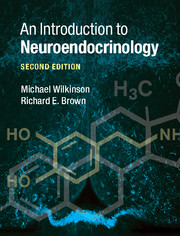Book contents
- Frontmatter
- Dedication
- Contents
- Preface to the second edition
- Acknowledgements
- List of abbreviations
- 1 Classification of chemical messengers
- 2 The endocrine glands and their hormones
- 3 The pituitary gland and its hormones
- 4 The hypothalamic hormones
- 5 Neurotransmitters
- 6 Neurotransmitter and neuropeptide control of hypothalamic, pituitary and other hormones
- 7 Regulation of hormone synthesis, storage, release, transport and deactivation
- 8 Regulation of hormone levels in the bloodstream
- 9 Steroid and thyroid hormone receptors
- 10 Receptors for peptide hormones, neuropeptides and neurotransmitters
- 11 Neuropeptides I: classification, synthesis and co-localization with classical neurotransmitters
- 12 Neuropeptides II: function
- 13 Cytokines and the interaction between the neuroendocrine and immune systems
- 14 Methods for the study of behavioral neuroendocrinology
- 15 An overview of behavioral neuroendocrinology: present, past and future
- Index
- References
14 - Methods for the study of behavioral neuroendocrinology
Published online by Cambridge University Press: 05 June 2015
- Frontmatter
- Dedication
- Contents
- Preface to the second edition
- Acknowledgements
- List of abbreviations
- 1 Classification of chemical messengers
- 2 The endocrine glands and their hormones
- 3 The pituitary gland and its hormones
- 4 The hypothalamic hormones
- 5 Neurotransmitters
- 6 Neurotransmitter and neuropeptide control of hypothalamic, pituitary and other hormones
- 7 Regulation of hormone synthesis, storage, release, transport and deactivation
- 8 Regulation of hormone levels in the bloodstream
- 9 Steroid and thyroid hormone receptors
- 10 Receptors for peptide hormones, neuropeptides and neurotransmitters
- 11 Neuropeptides I: classification, synthesis and co-localization with classical neurotransmitters
- 12 Neuropeptides II: function
- 13 Cytokines and the interaction between the neuroendocrine and immune systems
- 14 Methods for the study of behavioral neuroendocrinology
- 15 An overview of behavioral neuroendocrinology: present, past and future
- Index
- References
Summary
Behavioral neuroendocrinology involves the study of the interactive effects of steroid and peptide hormones, neuropeptides, cytokines and neurotransmitters on behavior. Previous chapters have mentioned the role of hypothalamic nuclei in behavior (section 4.1), the behavioral effects of neurotransmitter agonists and antagonists (section 5.8.4), the neuroendocrine correlates of psychiatric disorders (section 6.8), the behavioral functions of steroid hormones (sections 9.9.3 and 9.9.4), the cognitive and behavioral effects of neuropeptides (section 12.7) and the effects of cytokines on the brain and behavior (section 13.5). The present chapter discusses behavioral methods used in the study of neuroendocrinology, the neural and genetic mechanisms mediating the effects of hormones on behavior, and some of the special problems involved in conducting behavioral neuroendocrinology research.
Neuroendocrine research utilizes several specific methods such as immunoradiometric assays for quantifying hormone levels (Chapter 8), immunohistochemistry (Chapter 9) and immuno fluorescence techniques for localizing hormones (Chapters 11 and 12). The study of behavioral neuroendocrinology relies on specific behavioral methodologies or behavioral bioassays. As discussed in Chapter 8 (section 8.1.3), a bioassay measures physiological changes in an animal or cell culture to determine the concentration or potency of a hormone in the circulation. Thus, for example, the size of a cock's comb is a bioassay for blood testosterone level and in rats the size and weight of the adrenal glands is a bioassay for the level of circulating ACTH or corticosterone. A behavioral bioassay measures behavioral changes to estimate the concentration or potency of a hormone.
Behavioral bioassays
A behavioral bioassay requires precise qualitative (verbal) descriptions of the behaviors of interest and accurate quantitative (mathematical) measures of the latency, frequency and duration of these behaviors. Thus, the measurement of behavior involves two stages: the observation and description of units of behavior and the quantitative measurement of these behavior units. Before these procedures can begin, however, one must determine which behaviors to record.
- Type
- Chapter
- Information
- An Introduction to Neuroendocrinology , pp. 400 - 457Publisher: Cambridge University PressPrint publication year: 2015

